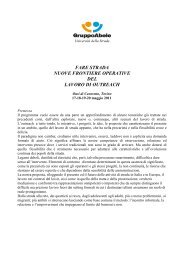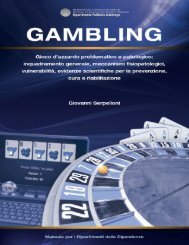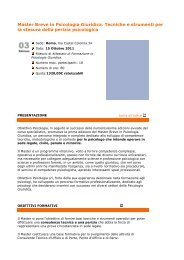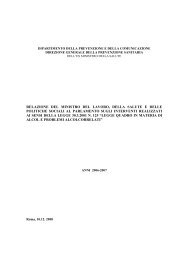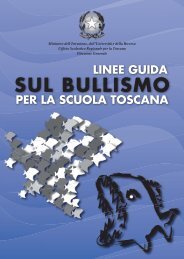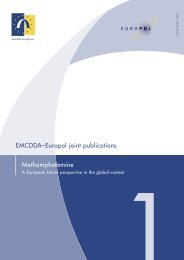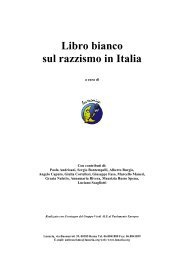Neuroscienze e dipendenze - Dipartimento per le politiche antidroga
Neuroscienze e dipendenze - Dipartimento per le politiche antidroga
Neuroscienze e dipendenze - Dipartimento per le politiche antidroga
You also want an ePaper? Increase the reach of your titles
YUMPU automatically turns print PDFs into web optimized ePapers that Google loves.
60 - E<strong>le</strong>menti di NEUROSCIENZE E DIPENDENZE<br />
BIBLIOGRAFIA<br />
1. Benthin A, Slovic P, Severson H. A psychometric study of ado<strong>le</strong>scent risk <strong>per</strong>ception. Journal of Ado<strong>le</strong>scence 1993;16:153-168. [PubMed:<br />
8376640J<br />
2. Bjork JM, Knutson B, Fong GW, Caggiano DM, Bennett SM, Hommer DW. Incentive-elicited brain activation in ado<strong>le</strong>scents: Similarities and<br />
differences from young adults. Journal of Neuroscience 2004;24: 1793-1802. [PubMed: 14985419J<br />
3. Bjorkland, DF. The ro<strong>le</strong> of conceptual know<strong>le</strong>dge in the development of organization in children’s memory. In: Brainerd, CJ.; Press<strong>le</strong>y, M., editors.<br />
Basic processes in memory development: Progress in cognitive development research. New York: Springer-Verlag; 1985. p. 103-142.<br />
4. Bjorkland DF. How age changes in know<strong>le</strong>dge base contribute to the development of children’s memory:<br />
An interpretive review. Developmental Review 1987;7:93-130.<br />
5. Bourgeois JP, Goldman-Rakic PS, Rakic P. Synaptogenesis in the prefrontal cortex of rhesus monkeys.<br />
Cerebral Cortex 1994;4:78-96. [PubMed: 8180493J<br />
6. Brainerd CJ, Reyna VF. Memory independence and memory interference in cognitive development.<br />
Psychological Review 1993; 100:42-67. [PubMed: 8426881 J<br />
7. Brown IT, Lugar HM, Coalson RS, Miezin FM, Petersen SE, Schlaggar BL. Developmental changes in human cerebral functional organization<br />
for word generation. Cerebral Cortex 2005; 15 :275-290. [PubMed: 15297366J<br />
8. Bunge SA, Dudnkovic NM, Thomason ME, Vaidya CJ, Gabrieli JD. Immature frontal lobe contributions to cognitive control in children: Evidence<br />
from fMRI. Neuron2002;33:30l-311. [PubMed: 11804576J<br />
9. Case R. Validation of a neo- Piagetian capacity construct. Journal of Ex<strong>per</strong>imental Child Psychology 1972;14:287-302.<br />
10. Case, R. Intel<strong>le</strong>ctual development: Birth to adulthood. New York: Academic Press; 1985.<br />
11. Casey BJ, Castellanos FX, Giedd IN, Marsh WI., Hamburger SD, Schubert AB. Implication of right frontostriatal circuitry in response inhibition<br />
and attention-deficit/hy<strong>per</strong>activity disorder. Journal of the American Academy of Child and Ado<strong>le</strong>scent Psychiatry 1997;36:374-383.<br />
[PubMed: 9055518J Casey BJ, Galvan A, Hare TA. Changes in cerebral functional organization during cognitive development.<br />
12. Current Opinion in Neurobiology 2005; 15:239-244. [PubMed: 15831409J<br />
13. Casey BJ, Giedd IN, Thomas KM. Structural and functional brain development and its relation to cognitive development. Biological Psychology<br />
2000a;54:241-257. [PubMed: 11035225J<br />
14. Casey BJ, Thomas KM, Davidson MC, Kunz K, Franzen PL. Dissociating striatal and hippocampal function developmentally with a stimulus-response<br />
compatibility task. Journal of Neuroscience 2002a;22:8647-8652. [PubMed: 12351738J<br />
15. Casey BJ, Thomas KM, Welsh TF, Badgaiyan RD, Eccard CH, Jeunings JR, et al. Dissociation of response conflict, attentional se<strong>le</strong>ction, and<br />
expectancy with functional magnetic resonance imaging. Proceedings of the National Academy of Science 2000b;97:8728-8733.<br />
16. Casey BJ, Tottenham N, Fossella J. Clinical, imaging, <strong>le</strong>sion and genetic approaches toward a model of cognitive control. Developmental<br />
Psychobiology 2002b;40:237-254. [PubMed: 11891636J<br />
17. Casey BJ, Tottenham N, Liston C, Durston S. Imaging the developing brain: What have we <strong>le</strong>arned about cognitive development Trends<br />
in Cognitive Science 2005;9: 104-110.<br />
18. Casey BJ, Trainor RJ, Orendi JL, Schubert AB, Nystrom I.E, Giedd IN, et al. A developmental functional MRI study of prefrontal activation<br />
during <strong>per</strong>formance of a go-no-go task. Journal of Cognitive Neuroscience 1997;9:835-847.<br />
19. Crone E, Donohue S, Honomichl R, Wendelken C, Bunge S. Brain regions mediating f<strong>le</strong>xib<strong>le</strong> ru<strong>le</strong> use during development. Journal of Neuroscience<br />
2006;26: 11239-11247. [PubMed: 17065463J Dempster, FN. Resistance to interference: Developmental changes in a basic<br />
processing mechanism. In: Howe, ML.; Pasnak, R., editors. Emerging themes in cognitive development Volume 1: Foundations. New York:<br />
Springer; 1993. p. 3-27.<br />
20. Diamond A. Development of the ability to use recall to guide action, as indicated by infants’ <strong>per</strong>formance on AB. Child Development<br />
1985;56:868-883. [PubMed: 4042750J<br />
21. Durston S, Davidson MC, Thomas KM, Worden MS, Tottenham N, Martinez A, et al. Parametric manipulation of conflict and response competition<br />
using rapid mixed-trial event-related fMRI. Neuroimage 2003;20:2135-2141. [PubMed: 14683717J<br />
22. Durston S, Davidson MC, Tottenham N, Galvan A, Spicer J, Fossella J, et al. A shift from diffuse to focal cortical activity with development.<br />
Developmental Science 2006; 1: 18-20. [PubMed: 16445391 J Durston S, HulshoffPol HE, Casey BJ, Giedd IN, Buitelaar JK, van Engeland<br />
H. Anatomical MRI of the developing human brain: What have we <strong>le</strong>arned Journal of American Academy of Child Ado<strong>le</strong>scent<br />
Psychiatry 2001 ;40: 10 12-1020.<br />
23. Eaton LK, Kinchen S, Ross J, Hawkins J, Harris W A, Lowry R, et al. Youth risk behavior surveillance -United States, 2005, surveillance summaries.<br />
Morbidity and Mortality Weekly Report 2006;55: 1 108. [PubMed: 16410759J<br />
24. Eigsti 1M, Zayas V, Mischel W, Shoda Y, Ayduk 0, Dadlani MB, et al. Predicting cognitive control from preschool to late ado<strong>le</strong>scence and<br />
young adulthood. Psychological Science 2006; 17:478-484. [PubMed: 16771797J<br />
25. Ernst M, Nelson EE, Jazbec S, McClure EB, Monk CS, Leibenluft E, et al. Amygdala and nuc<strong>le</strong>us accumbens in responses to receipt and<br />
omission of gains in adults and ado<strong>le</strong>scents. Neuroimage 2005;25:1279-1291. [PubMed: 15850746J<br />
26. Eshel N, Nelson EE, Blair RJ, Pine DS, Ernst M. Neural substrates of choice se<strong>le</strong>ction in adults and ado<strong>le</strong>scents: Development of the ventrolateral<br />
prefrontal and anterior cingulate cortices. Neuropsychologia 2007;45: 1270-1279. [PubMed: 17118409J<br />
27. Flavell JH, Feach DR, Chinsky JM. Spontaneous verbal rehearsal in a memory task as a function of age. Child Development 1966;37:283-<br />
299. [PubMed: 5941895J<br />
28. Galvan A, Hare TA, Parra CE, Peun J, Voss H, Glover G, et al. Earlier development of the accumbens relative to orbitofrontal cortex might<br />
underlie risk-taking behavior in ado<strong>le</strong>scents. Journal of Neuroscience 2006;26:6885-6892. [PubMed: 16793895J<br />
29. Galvan A, Hare T, Voss H, Glover G, Casey BJ. Risk-taking and the ado<strong>le</strong>scent brain: Who is at risk Developmental Science 2007;1O:F8-<br />
F14. [PubMed: 17286837J<br />
30. Gardener M, Steinberg L. Peer influence on risk taking, risk preference, and risky decision making in ado<strong>le</strong>scence and adulthood: An ex<strong>per</strong>imental<br />
study. Developmental Psychology 2005;41:625-635. [PubMed: 16060809J<br />
31. Giedd IN. Structural magnetic resonance imaging of the ado<strong>le</strong>scent brain. Annals of the New York Academy of Sciences 2004;1021:77-<br />
85. [PubMed: 15251877J



